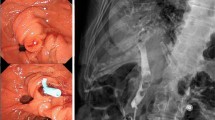Abstract
A 38-year-old woman was treated for malignant stricture by the endoscopic placement of a biliary endoprosthesis. She developed a large retroperitoneal biloma secondary to acute duodenal perforation by the stent. We describe the successful percutaneous retrieval of the biliary stent through a retroperitoneal approach which also permitted drainage of the biloma.
Similar content being viewed by others
References
Nosher JL, Siegel R (1993) Percutaneous retrieval of nonvascular foreign bodies. Radiology 187:649–651
Grabenwoeger F, Bardach G, Dock W, Pinterits F (1988) Percutaneous extraction of centrally embolized foreign bodies: A report of 16 cases. Brit J Radiol 61:1014–1018
Uflacker R (1991) Percutaneous retrieval of intravascular foreign bodies. In: Kadir S (ed): Current practice of interventional radiology. B.C. Decker, Philadelphia, pp 121–126
Yedlicka JW, Carlson JE, Hunter DW, Castañeda-Zúñiga WR, Amplatz K (1991) Nitinol Goose Neck snare for removal of foreign bodies: Experimental study and clinical evaluation. Radiology 78:691–693
Sanchez RB, Roberts AC, Valji K (1992) Wallstent misplaced during transjugular placement of an intrahepatic portosystemic shunt: Retrieval with a loop snare. AJR 159:129–130
Smith SJ, Vydorny C, Vogelzang RL (1994) Percutaneous extraction of two deeply lodged foreign bodies. Cardiovasc Intervent Radiol 17:113–115
Gould J, Train J, Dan S, Mitty H (1988) Duodenal perforation as a delayed complication of placement of biliary endoprosthesis. Radiology 167:467–469
Lammer J, Neumayer K (1986) Biliary drainage endoprosthesis: Experience with 201 placements. Radiology 159:625–629
Byrne P, Leung JWC, Cotton PB (1984) Retroperitoneal perforation during duodenoscopic sphincterotomy. Radiology 150:383–384
Smith FCT, O'Connor HJO, Downing R (1991) An endoscopic technique for stent recovery used after duodenal perforation by a biliary stent. (letter) Endoscopy 23:244–245
Coppola R, Masetti R, Riccioni ME, Ciletti S, DeFranco A, Detweiler M, Magistrelli P, Picciocchi A (1993) Early retroduodenal perforation following endoscopic internal biliary drainage. (letter) Endoscopy 25:255–256
Cekirge S, Weiss JP, Foster RG, Neiman HL, McLean GK (1993) Percutaneous retrieval of foreign bodies: Experience with the nitinol Goose Neck snare. J Vasc Intervent Radiol 4:805–810
Author information
Authors and Affiliations
Rights and permissions
About this article
Cite this article
Bui, B.T., Oliva, V.L., Ghattas, G. et al. Percutaneous removal of a biliary stent after acute spontaneous duodenal perforation. Cardiovasc Intervent Radiol 18, 200–202 (1995). https://doi.org/10.1007/BF00204152
Issue Date:
DOI: https://doi.org/10.1007/BF00204152




